Use of Ringing Cedars of Russia cedar products for prophylaxis and improving the health of the population
E. L. Poteryaeva, PhD, Head of the Department of Human Ecology and Occupational Diseases, Professor.
N. G. Nikiforova, PhD, Professor in the Department of Human Ecology and occupational Diseases.
Novosibirsk State Medical Academy
Department of Human Ecology and Occupational Diseases
Introduction
At the present, environmental pollution has reached a critical level. The increased content of various toxic substances and heavy metals in the atmosphere, water reservoirs, and soil facilitates their entry and accumulation in the human organism.
The intensive and prolonged effects of ecologically unfavourable environmental factors can lead to an overload of adaptational systems and the development of premorbid and morbid conditions. In addition, when many modern food products undergo industrial processing, they lose a large number of valuable nutrients, vitamins, and trace elements, and are supplemented by various additives in the form of preservatives, bleaches, fillers, etc., which increases the load on the basic defensive systems of the organism.
In conditions of modern pressures that are not only technogenic but also medicinal, the search for preparations of natural origin for the "gentle" correction of the conditions in question is especially topical. Cedar nut oil under Ringing Cedars of Russia brand name may be included in these preparations.
Environmental situation in the world

In the past few years, the environmental situation has essentially not improved, in spite of the fact that, as a whole, the international community has assumed the obligation to reduce the emission of hazardous substances into the atmosphere and the discharge of polluted sewage into surface water sites. For the absolute majority of large, medium, and even small cities, typical problems include air pollution, the neutralization and recycling of toxic industrial waste products, and radiation protection.
In many cities, the pressing issues are those of the pollution of surface waters, and the pollution and exhaustion of subterranean waters, while the problems of preserving the fertility of soils and lands are topical for all countries.
In a number of regions, anthropogenic loads have long ago exceeded the established norms, and a critical situation has arisen in which significant changes in the landscape are occurring, the exhaustion and loss of natural resources is taking place, and the conditions of life for the population are becoming significantly worse. These regions include the largest cities of the world and industrial centres. They exert a negative influence on the environmental state of neighboring regions.
In this regard, more than 60% of the world's population lives in cities where specific indices of environmental pollution to a unit of area are too high. Thus, for a unit of area in a large metropolis, approximately 114.04 tons of hazardous substances per square kilometre are emitted into the atmosphere, and 1480.15 thousand cubic metres of polluted sewage per square kilometre are discharged into surface water reservoirs.
The atmospheric route for the entry of toxic substances into the human organism is the leading one, since, in a twenty-four hour period, a person consumes approximately 15 kg of air, 2.5 kg of water, and roughly 1.5 kg of food, and in addition, when inhaling, chemical elements are absorbed by the organism the most intensively.
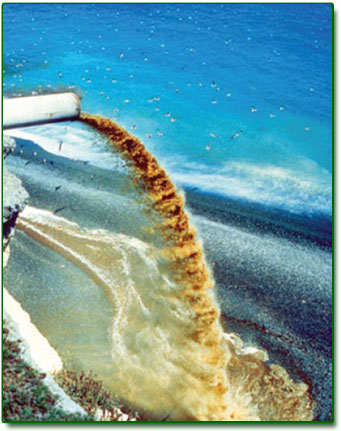
On the basis of data respecting levels of atmospheric pollution by various chemical substances, data obtained using a method of expert evaluations, it has been determined that the largest group of the population is subjected to the influence of suspended matter, among which first place is occupied, according to the extent of its influence, by benzopyrene, followed by nitrogen dioxide, hydrogen fluoride, carbon disulfide, formaldehyde, carbon monoxide, ammonia, and styrene.
For a number of regions, typically present in the air are substances specific for the emissions of individual industries (asbestos, vinyl chloride, heavy metal salts, lead, mercury, cadmium, nickel, copper).
The basic polluting substances contained in the air of almost all cities include suspended matter, nitrogen and sulfur dioxide, carbon monoxide, and phenol.
Expert evaluations of environmental risk as the probability of a negative influence of polluting substances on the health of the population have shown that the general annual number of cases of death from atmospheric pollution by suspended matter is equal to roughly 16,000 cases for a population of 15 million persons, which comes to 5% of the annual cases of death.
The most dangerous for the health of the population are increased concentrations of suspended matter, nitrogen dioxide, benzene, benzopyrene, arsenic, cadmium, nickel, and vinyl chloride.
The basic source of the pollution of the atmosphere of cities by lead is automobile transport that uses leaded gasoline. The percentage of samples exceeding the maximum allowable concentration increases in proximity to motorways.
In addition, in the past few years, almost all surface water-supply sources have become exposed to pollution. The quality of subterranean water used for the water supply corresponds on the whole to the standard requirements, however their pollution is also increasing.
The quality of potable water in countries is not improving, every third person who uses central water-supply systems receives water that does not meet sanitary requirements according to a number of indices.
Investigations show that only 1% of water samples from surface water-supply sources correspond to Class I (the water does not require special processing), while 17% of the samples cannot be assigned even to Class III.
The presence in centralized water-supply sources of highly toxic organic compounds, heavy metal salts, petroleum products, phenols, chloroorganic compounds, and other polluting substances in concentrations that exceed sanitary standards in the face of the insufficient "blocking" capability of operating water-treatment plants creates a serious danger for the health of the population, and leads to bodily diseases.
Environmental dependence of diseases
At the present time, the increase in the frequency of the following chronic pathological processes is considered to be directly or indirectly related to the growing influence of the unfavourable factors of an industrial society:
- Chronic illnesses of the respiratory organs
- Genetic and congenital defects
- Chronic poisonings and drug complications
- Malignant tumours and blood diseases
- Chronic diffuse diseases of the liver
- Peptic ulcers
- Arterial hypertension, atherosclerosis, and ischemic disease of the heart
- Neuroses, neurasthenia, and vegetative vascular dystonia
- Caries and atrophy of the gums
- Disturbances of vision and hearing
- Increase in the mortality rate from cirrhosis of the liver of toxic and chemical etiology and tumour processes
|

Changes in the structure and nature of the pathology of modern people in many respects is related to global technogenic transformations and environmental pollution. The human organism, exposed to the influence of harmful factors, is constantly required to mobilize its compensatory-adaptive mechanisms, whose reserves are limited and with time may become exhausted. In the end, the intense and prolonged influence of ecologically unfavourable factors of the environment may cause an overstrain and breakdown of the organism's adaptational processes, and thereby facilitate the development of premorbid and various pathological conditions of a person, which bear more and more pronounced features of environmental dependency (A).
By analogy with natural focal diseases, one can speak about a relatively new and little studied phenomenon - the focal nature of the ecological pathology of a person. An epicentre is distinguished, where the basic sources of continual environmental pollution are located. Further, several zones (a minimum of two) are located around the epicentre. In the zones beyond the epicentre, the harmful influence of production factors is indirect, more delayed and altered.
With regard to the origin and prevalence of the focal point of socio-environmental stress in one zone or another, the following classification of environmentally significant diseases may be distinguished (A):
- Indicated environmental pathology - reflects a high degree of dependence of a health condition on environmental pollution (occupational diseases, oncological diseases, perinatal mortality, congenital pathology, genetic defects, allergic diseases and reactions, toxicological injuries);
- Environmentally dependent pathology - reflects an average degree of dependence on environmental pollution (infantile mortality, mortality of young children, general child mortality, secondary immunodeficiencies, neonatal mortality, chronic bronchitis and pneumonia in children, chronic parenchymatous lesions of the liver and bile ducts, aggravation of basic diseases of the respiratory and cardiovascular systems on days of an abrupt worsening in the meteorological situation in cities);
- Environmentally conditioned pathology - reflects a moderate dependence on an environmental state (spontaneous miscarriages, pathology of pregnancy, chronic bronchitis and pneumonia in adults, morbidity with a temporary loss of the ability to work, anemia in children, basic diseases of the cardiovascular system, increase in the prenosological indices of the measure of the risk of leading systemic diseases).
|

Environmentally significant pathology includes microelementosis. Microelementosis is the name given to pathological conditions caused by a deficiency, surplus, or imbalance of macroelements and trace elements. Despite the fact that diseases of this nature have long been familiar to clinical medicine (endemic goiter, iron-deficiency anemias, poisoning by some metals, etc.), they were not, however, distinguished by a unifying name. The overwhelming majority of diseases and syndromes of this class were almost not recorded, since clinically they passed under other "masks" (Skalnyy, 2000).
An extremely widespread and perhaps, in modern conditions, the most important group of microelementoses are the technogenic ones. Among them, especially well studied are the industrial, mainly, occupational diseases. Comparatively recently they were the object of the close attention of epidemiologists, who distinguished proximal microelementoses, i.e., diseases of people who do not participate in production itself, but who live in the vicinity.
In recent decades, the attention of not only scientists, but also the general public has been drawn to transgressive microelementoses. This term is used to define diseases that occur at a significant distance from the production zone as a result of the atmospheric or aqueous transfer of chemical hazards, in particular, microelementoses. Acid rain is a typical example of transgression.
Environmental pollution by toxic metals affects children first and foremost, since an intensive accumulation of various harmful elements occurs even in the placenta. This leads to the appearance of congenital deformities, a reduction in immunity, the development of many diseases, often with a synchronization of the pathological process, and a delay of mental and physical development. A generation of weakened people grows up susceptible to infection with a high risk of developing ischemic heart disease and cancerous pathologies.
Thus, environmental pollution makes a very substantial contribution to the development of premorbid and pathological conditions. The universal mechanisms of a disturbance in homeostasis play a role in the development of these conditions: the activation of free-radical oxidation together with a reduction in the reserve of endogenous antioxidants, a reduction in immunity, a deficit of essential trace elements, etc.
Contemporary concepts regarding the methods of prophylaxis, rehabilitation, and treatment in the face of the influence of harmful environmental factors
The basic consequences of environmentally caused disturbances may be separated into three basic blocks (B):
- An environmentally caused increase in the frequency of complications in pregnancy and childbirth, spontaneous miscarriages, congenital anomalies in development and genetic defects, prenatal, perinatal and infantile mortality;
- An environmentally caused increase of immunodeficient states and the morbidity of children because of chronic diseases of the respiratory and digestive organs, oncological and allergic diseases, and diseases of the blood, liver. and kidneys;
- An environmentally caused increase among the adult population of the frequency of oncological processes, occupational diseases, chemical hypersensitivity, and latent chronic poisoning, secondary immunodeficiencies, chronic diseases of the systems of the respiratory and circulatory organs, diseases of the liver and blood, and dystrophic processes.
|
At the present, it is well known that, in conditions of environmental danger, the most widespread diseases are those of the organs and systems that function as barriers on the border of the two environments - the internal and the external.
Three basic lines of defence may be distinguished (B):
- The skin, blood, and lymph, lungs and mucosa of the respiratory tract, gastrointestinal tract;
- The liver and immune system;
- The excretory system (kidneys, bile ducts, stomach, bowels, the skin, lymph flow).
|
The basic goal in the prophylaxis of premorbid and morbid conditions is the synchronous control of the basic metabolic, detoxifying, and protective functions of the liver, the immune system, and the excretory organs.
Grounds for the use of cedar nut products for population health care in the conditions of an unfavorable environmental situation.
Composition and properties of cedar nut oil under Ringing Cedars of Russia trade mark
Cedar nut oil is obtained from the cleaned nut by the method of cold pressing by wooden presses, which makes it possible to preserve the entire complex of its useful components.
The oil of the cedar nut contains: 95% lipids; 5% nitrogen compounds, of which 90% are made up of amino acids; vitamins: fat-soluble vitamins (A, E, K, D), the water-soluble group B vitamins; macroelements and trace elements.
Lipids in cedar nut oil
Table 1. Content of unsaturated fatty acids in cedar nut oil
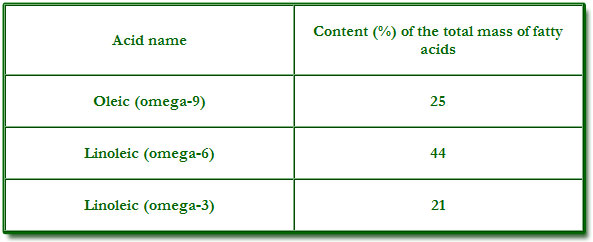
The tables present data from studies carried out in the laboratories of the Siberian Academy of Technology and the Krasnoyarsk State Medical Academy.
It is evident from the table that the ratio of omega-6/omega-3 fatty acids is approximately 2:1. A necessary condition is also the sufficient intake with the food of tocopherols, natural antioxidants, since the excess consumption of only polyunsaturated fatty acids can lead to the activation of the processes of lipid peroxide oxidation. Cedar nut oil contains 55 mg of alpha-tocopherol.
Cedar nut oil contains a large number of complex lipids-phospholipids and glycolipids-which exceeds their content in all nut and oil crops. A distinctive feature of their fractional composition is the presence of cerebrosides that are nonspecific for vegetable substances. In contrast to simple lipids (fats and fatty acids), used as an energy material, complex lipids perform building functions and are used mainly as structural components of biological membranes.
Thus, the value of the lipid composition of cedar nut oil is determined by the high content and close to optimum relationship of mono- and polyunsaturated fatty acids, as well as by the presence of other factors of a lipid nature that possess a high physiological activity.
Vitamins and mineral substances in Ringing Cedars of Russia cedar nut oil
Cedar nut oil is a rich source of vitamins and mineral substances.
Table 2. Composition of vitamins in cedar nut oil
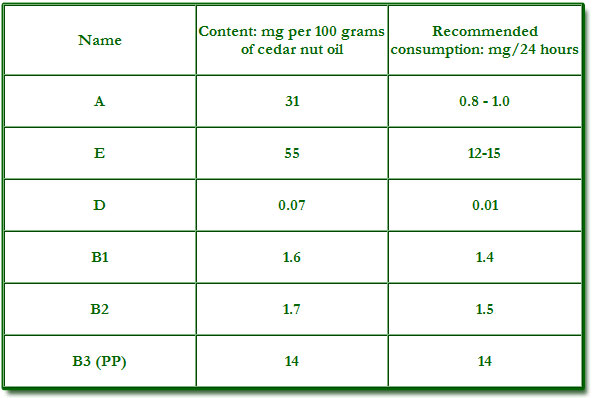
- Vitamin A - the vitamin for growth and development;
- Vitamin B1 (thiamine) - which regulates the oxidation of carbohydrate metabolism products, and participates in the metabolism of amino acids, the formation of fatty acids and influences cardiovascular, digestive, glandular functions as well as the function of the central and peripheral nervous system;
- Vitamin B2 (riboflavin) - which helps the organism in the conversion of proteins, fats and carbohydrates into energy and is essential to the formation and sustenance of the fabric of the organism; it increases sensitivity of vision to light and colour, has a positive influence on the condition of the nervous system, skin and mucous membranes, the functioning of the liver and blood formation;
- Vitamin B3 (PP) (niacin) - participates in the processes of tissue respiration, improves carbohydrate metabolism, reduces the cholesterol level, normalizes the secretory and motor functions of the gastrointestinal tract, and has a vasodilator action. Which is important for fat synthesis, protein metabolism and food-energy conversion; it acts to regulate the higher nervous activity, the cardiovascular system, the functioning of the digestive organs, cholestorol metabolism and blood formation;
- Vitamin E (tocopherol), which influences the functions of the sex and other vascular glands, stimulates the action of the muscles, participates in the metabolism of proteins and carbohydrates, facilitates the digestion of fats, Vitamins A and O, and also protects cell membranes from injury.
- Vitamin D regulates the exchange of calcium and phosphorus, ensures the absorption of these substances in the bowels and their deposit in growing bone, thus ensuring the strength of bones and teeth, and influences the permeability of cellular and subcellular membranes to calcium ions.
|
Cedar nut oil contains a complex of the most important macroelements and trace elements necessary for the normal vital activity of the organism (D).
Table 3. Composition of macroelements and trace elements in cedar nut oil
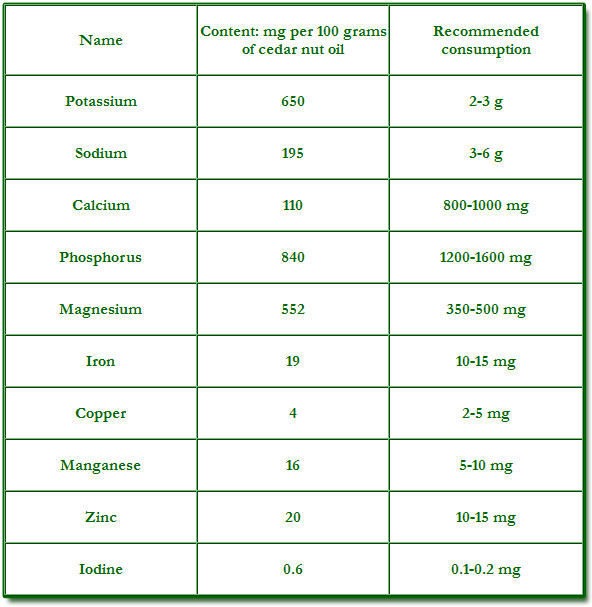
- Sodium has an influence on the activity of practically all systems of the organism.
- copper - which is involved in the functioning of the brain and is essential for the formation of red corpuscles;
- magnesium - which is required for the formation of correct bone structure, and is also an important component of soft tissue;
- manganese - which is essential for the tendrons and hormones and helps the organism take in glucose; it also participates in the activity of the enzymes in the reproductive process, as well as growth and fat metabolism;
- silicon - which facilitates the formation and elasticity of the organism's connective tissue, and also participates in the calcification of the bones;
- vanadium - which retards the formation of cholestorol in the blood vessels; it also participates in the activity of the enzymes, in the metabolism of glucose and fat, and in the development of bones and teeth;
- potassium - which regulates the organism's water balance; it also assists in the normalisation of cardiac contractions and supplying nutrition to the muscle system;
- phosphorous - which is involved in the formation and maintenance of teeth and bones and plays an important role in the activity of the muscles and nerve cells and in quick energy release;
- calcium - which is the main component of bones and teeth and is essential for blood coagulation, cell integrity and heart action; it is also important for normal muscle contraction and the functioning of the nervous system;
- molybdenum - which assists in the metabolism of carbohydrates and fats, and facilities prevention of blood deficiency;
- nickel - a deficiency of which influences blood formation and retrads growth, along with changes in the content of iron, copper and zinc in the liver;
- iodine - which is part of the hormones of the thyroid gland and is essential for full metabolism processes;
- tin - a deficiency of which in the organism may lead to retardation of growth;
- boron - a deficiency of which can weaken mental alertness and the capacity to bear physical burdens;
- zinc - which plays a vital role in the restoration of tissue, normal skeletal growth and muscle contraction, and also helps in healing wounds and contributes to the normal functioning of the prostate gland;
- iron - which is the most important component in hemoglobin and protein.
|
Apart from the micronutrients listed above, cedar nut oil also contain barium, titanium, silver, aluminium, iodide, cobalt and sodium.
Health-improvement potential of Ringing Cedars of Russia cedar nut oil in conditions involving the influence of harmful environmental factors
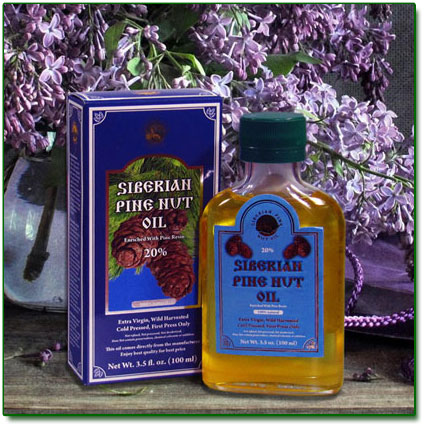
Because of the richness of its chemical composition, cedar nut oil under Ringing Cedars of Russia brand has wide latitude of beneficial action on the organism.
The regular use of cedar nut oil enriches the diet with many indispensable nutritional factors - polyunsaturated fatty acids, amino acids, vitamins, macroelements and trace elements.
The oil of the cedar nut has a beneficial influence on metabolic processes in all tissue structures of the human organism.
The fatty acid composition of Ringing Cedars of Russia cedar nut oil is characterized by a high content of mono- and polyunsaturated fatty acids.
The necessity to observe a balance between the different classes of fatty acids is well known. The World Health Organization recommends adhering to a ratio of from 4:1 to 10:1, in this case one should strive to increase the portion of omega-3 fatty acids, since an excess of omega-6 fatty acids does have worse consequences for health.
In Ringing Cedars of Russia cedar nut oil, the ratio of omega-6/omega-3 fatty acids comes to approximately 2:1. Regular use of unsaturated fats makes it possible to reduce the levels of triglycerides and cholesterol in the blood. An increase in the proportion of unsaturated fatty acids in the lipid spectrum of the blood plasma impedes the further formation of atherosclerotic platelets and can contribute to their reverse development.
The high content of vitamins A and E in cedar nut oil gives it the properties of a natural antioxidant. In recent years, the problem of lipid peroxide oxidation and formation of free radicals has been attracting considerable attention in population health care fields. In normal conditions of vital activities, many important metabolic and physiological processes occur with the formation of free radicals. They are involved in the accumulation and biotransformation of energy, ensure the detoxification of some foreign compounds, participate in the work of the nonspecific immunological protection system of the organism. Within a standard, the intensity of the processes of free-radical oxidation is supported at a specific level by a complex antioxidant defence system.
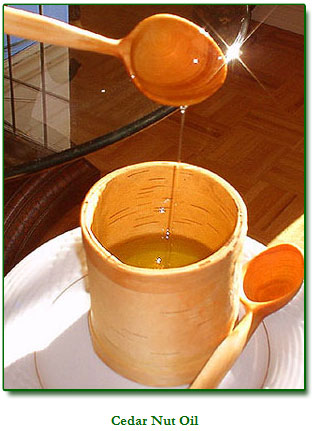
The contamination of the external and internal environment of the organism by toxic substances, constant psychological and emotional stress, significant physical loads, the use of a large quantity of refined carbohydrates and animal fats in food all lead to the exhaustion of the natural antioxidant defence systems and the excessive activation of free-radical oxidation.
When free radicals enter into chemical reactions, they damage fermentation systems, lipids, proteins, and nucleic acids, and lead to disturbances in cell function, they are considered to be the culprits in many acute and chronic illnesses as well as the premature aging of the organism.
Ringing Cedars of Russia cedar nut oil is an effective natural antioxidant, and may be used for the prophylaxis of any illness whose onset and development is related to the activation of the processes of free-radical oxidation.
Cedar nut oil is traditionally used in the treatment of catarrhal diseases as a general fortifying remedy and one that increases the nonspecific immune defence. It is used in the form of oil irrigations or it is taken internally. Vitamins A, E, B, polyunsaturated fatty acids, and trace elements, which form part of cedar nut oil, exert a softening and antipyretic action on the mucous membranes of the upper respiratory tract, and strengthen the processes of regeneration in them.
The ability of Ringing Cedars of Russia cedar nut oil to accelerate the processes of the regeneration (restoration) of mucous membranes is also made use of in the treatment of diseases of the gastrointestinal tract.
Ringing Cedars of Russia cedar nut oil may be used externally for the cleansing, nourishment, and protection of the skin on all parts of the body. Cedar nut oil dissolves readily and removes all impurities, and provides valuable nourishment to the cleansed skin. In this case, it is good to combine the external application of cedar nut oil with its use in food in order to act on the skin "from the inside."
The use of Ringing Cedars of Russia cedar nut oil thus creates the conditions for an improvement in the functional condition of the skin, and the mucous membranes of the respiratory tract and gastrointestinal tract - the organs of the first line of the organism's defence in conditions of ecological danger.
Conclusion
Modern studies of the food allowance have revealed substantial deviations in the structure of the diet of the population from the formula of a balanced diet: a deficiency has been noted in micronutrients - vitamins, minerals, unsaturated fatty acids, and an entire series of organic compounds of plant origin; with regard to macronutrients, the food allowance is deficient in proteins and dietary fibers, and has an excess of animal fats.
The existing deficient structure of the diet exerts an unfavorable effect, first of all on the defensive strength of the organism - there is an increase in the risk of the development of different environmentally caused diseases.
Modern science possesses persuasive data to attest that, with the use of functional nutrition, it is possible to support an optimum level of vital activity and avoid many illnesses.
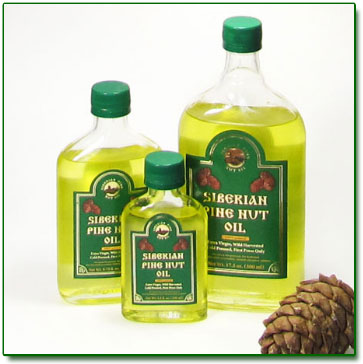
Ringing Cedars of Russia cedar nut products intended for prophylaxis and health improvement are manufactured according to modern conserving technologies, which make it possible to preserve all biologically active natural components in their primary form.
The series of health-improvement products based on Ringing Cedars of Russia cedar nut oil includes Cedar nut oil and Cedar nut oil enriched with cedar resin (Turpentine Balsam)
Thus, functional nutrition of Ringing Cedars of Russia cedar products - cedar nut oil and cedar nut oil enriched with cedar resin - are composed of a harmoniously balanced complex of biologically active substances, which exert a combined versatile action on organs and systems that are critical for the maintenance of the cleanliness of the internal environment of the human organism.
Functional nutrition of Ringing Cedars of Russia products - cedar nut oil and cedar nut oil enriched with cedar resin - consist of natural components, they do not contain preservatives or toxic substances; and therefore, there are no contraindications to their use, with the exception of any individual intolerance to separate components.
The high biological activity of the natural components of cedar products under Ringing Cedars of Russia brand name and the complex action of balanced nutrients are responsible for the health-improvement properties of these products in conditions of the influence of harmful environmental factors.
The use of Ringing Cedars cedar products intended for prophylaxis and health improvement is recommended for the inhabitants of large cities and environmentally unfavorable regions for prophylaxis and rehabilitation in the face of the influence of harmful environmental factors by maintaining the function of the liver and the immune system, as well as the organs of the excretory system.
BIBLIOGRAPHY
(A) Gichev, Yu, P. Human health as a basic bioindicator in an environmental monitoring system. Novosibirsk, 1994.
(B) Gichev, Yu, P. Environmental pollution and human health. Moscow-Novosibirsk, 2002.
(C) The influence of environmental pollution on human health -Materials of the First All - Russian Scientific Conference with International Participation. Edited by Professor Yu. P. Gichev. Novosibirsk, 2002.
(D) Obukhova, L. A. Products intended for health improvement and prophylaxis. Novosibirsk, 2003.
Updated and revised version.
Novosibirsk State Medical Academy
Department of Human Ecology and Occupational Diseases
Novosibirsk 2004
Image Copyrights:
http://www.thewatercoolercompany.com/
http://www.dietpharm.net/
http://kievres.kiev.ua/
http://www.ozonator101.ru/
Translation Copyright (c) RingingCeadrsofRussia.org
* * *
What People Say About This Product:
I have just placed my second order for Siberian pine nut oil because it is a miracle product. I ordered the product a month ago after doing research on the net for my father who lost 21 pounds from massive gastrointestinal problems. I pre-diagnosed him before his endoscopy, and he started taking the oil a week before his endoscopy.
He was diagnosed with a hiatal hernia and gastritis. Remarkably, after only taking pine nut oil for one week, they also found a healing ulcer. The doctor couldn't believe it. I am so happy to have found this product because my father was unable to eat due to extreme nausea, chronic belching, stomach pain and lightheadedness. He is now on the road to almost a full recovery and is eating again.
I want to thank Siberian for this miracle product and for answering our prayers. You saved his life! I am now spreading the word and want to share my story with everyone who is in need of a product that will answer their prayers as well.
Thank you,
Alicia H., Orange County, CA
* * *
I have taken the pine nut oil. I had 3 superficial stomach ulcers and gastritis. I took the PNO 2 tsp. 3x a day w/out taking Nexum prescribed by dr. I went to get my Endoscopic procedure on Dec. 19 and I was told no more ulcers and no gastritis. I told the dr. what I was taking and he was amazed by the results. Walked away shaking his head and saying to "There wasn't an even a trace of ulcer".
Regina Iannuzzi Sprague
Click here to go to our online store

CEDAR NUT OIL TOOTHPASTE "KEDRA"
Study of the effectiveness and
clinical results for anti-inflammatory
effect of Cedar Nut Oil toothpastes
over the entire period of the observations
The Department of Therapeutic Dentistry, Novosibirsk State Medical University
Associate Professor T. G. Petrova, Head of the Department of Preventive Dentistry
T. V. Zvereva, Candidate of Medical Sciences, Instructor in the Department of Preventive Dentistry

1. Purpose of the study: To determine the effectiveness of the therapeutic and prophylactic action of cedar nut oil toothpastes Kedra under Ringing Cedars of Russia sign.
2. Goals of the study: To evaluate the condition of patients' mouths prior to the use of the therapeutic and prophylactic cedar nut oil toothpastes Kedra.
- To study the cleansing properties of Kedra toothpastes after two and six weeks of use.
- To study the anti-inflammatory properties of cedar nut oil toothpastes Kedra after two and six weeks of use.
- To provide an evaluation of the organoleptic properties of Kedra toothpastes from the results of a survey.
3. Materials and methods of the study:
The study was carried out with the voluntary consent of patients of both sexes from 18 to 25 years of age. The test subjects did not have any medical contraindications, and undertook to use only the toothpaste issued to them. Prior to the beginning of the study, instructions were given to the test subjects regarding oral hygiene and the standard methods of brushing the teeth. It was recommended to all test subjects that they use brushes with soft and very soft bristles because of inflammation of the gums. No other forms of hygienic care for the mouth was permitted during the period of the study, as well as directed treatment of inflammatory diseases of the parodontium. Just before the study, all patients were given a professional cleaning of the oral cavity.
Twenty persons with chronic catarrhal gingivitis took part in the study.
Methods of brushing:
In the morning - Kedra with cedar nut oil and mint essential oil,
Evening - Kedra with Siberian cedar resin, cedar nut flour and cedar nut shell.
All patients underwent an interview process according to a specially developed questionnaire to evaluate the organoleptic properties of cedar nut oil toothpastes Kedra under Ringing Cedars of Russia sign.

In the study, indicators were recorded for the test subjects during their examination that classified the presence of dental tartar and plaque, and a clinical examination was made of the condition of the soft tissues of the mouth.
During the testing of the toothpastes, an evaluation of the level of oral hygiene was made according to the OHI-S index (Green, Vermillion, 1964), the tendency to bleed of the gums according to the GBI index (J. Silness, 1964, H. Loe, 1967), and the degree of gum inflammation according to the PMA index (C. Parma, 1960).
The cleansing effect was determined as a reduction of the OHI-S index according to the formula:
Effect (%) = 100 x [OHI-S(1) - OHI-S(2)]/OHI-S(1), where the indices OHI-S(1) and (2) refer to the first and subsequent examinations.
The hemostatic effect was determined as a reduction of the GBI index according to the formula:
Effect (%) = 100 x [GBI(1) - GBI(2)]/GBI(1), in which the indices GBI(1) and (2) refer to the first and subsequent examinations.
The anti-inflammatory effect was determined as a reduction of the PMA index according to the formula:
Effect (%) = 100 x [PMA(1) - PMA(2)]/PMA(1), in the formula the indices PMA(1) and (2) refer to the first and subsequent examinations.
4. Results of the study:
Only data received from the test subjects who had undergone the entire investigation in full were used. The average values of the indices being studied is presented in Table 1.
Table 1
Change in dental condition over the period of observation
Time of examination |
OHI-S |
GBI |
PMA |
Initial examination |
1.11 |
2.13 |
31.45 |
After two weeks |
0.7 |
1.56 |
16.74 |
After six weeks |
0.62 |
1.15 |
14.93 |
Evaluation of effectiveness (%) |
45.5 |
46 |
52.52 |
The application of Kedra toothpastes under Ringing Cedars of Russia over the course of six weeks demonstrated that, when used, an improvement of the hygienic condition of the mouth and the condition of the parodontium is observed.
Table 2
Change in the condition of the parodontium with the use of Kedra toothpastes according to the PMA index
Time of examination |
PMA indicator (%) |
Assessment of the anti-inflammatory effect (%) |
Initial examination |
31.45 |
- |
After two weeks |
16.74 |
46.77 |
After six weeks |
14.93 |
52.52 |
As it follows from Table 2, a marked anti-inflammatory effect was observed in patients with chronic catarrhal gingivitis with the use of Kedra toothpastes with cedar nut oil under Ringing Cedars of Russia sign, which was expressed in the reduction of the PMA indicator by 46.77% for the first two weeks, an even more intensive change in the indicator occurred over six weeks of use and came to 52.5%.
Table 3
Change in the numerical indicators of the Gingival Bleeding Index with the use of Kedra toothpastes over the period of the study
Time of examination |
Bleeding index indicator |
Assessment of the anti-inflammatory effect (%) |
Initial examination |
2.13 |
- |
After two weeks |
1.56 |
26.76 |
After six weeks |
1.15 |
46 |
On examining the history of the change in the degree of gingival bleeding with the use of Kedra toothpastes with cedar nut oil, a reduction in bleeding by 26.7% was found after two weeks, and by 46% after six weeks, which is evidence of a marked increase in the anti-inflammatory effect of Kedra toothpastes under Ringing Cedars of Russia sign over the entire period of the observations.
Table 4
Changes in the level of oral hygiene with the use of Kedra toothpastes according to the OHI-S index
Time of examination |
OHI-S indicator |
Assessment of cleansing effectiveness (%) |
Initial examination |
1.11 |
- |
After two weeks |
0.7 |
36 |
After six weeks |
0.6 |
45.5 |
On examining the change in the level of oral hygiene when using cedar nut oil toothpastes Kedra, an improvement in oral hygiene was found in patients with gingivitis. The increase in the indicator of cleansing effectiveness after two weeks of use by 37%, and after six weeks by 45.5% from the initial state indicates a good cleansing effect of the cedar nut oil toothpastes being studied.
A study of the organoleptic properties of the Kedra toothpastes with cedar nut oil indicated that 68% of the patients evaluate the taste of the paste as pleasant, while 74% of patients mention the pleasant aroma of the toothpastes (Table 5). The toothpastes did not have any localized irritating or allergenic effects on the mucous membrane of the mouth, and did not stain the hard tissue of the tooth. Of the people studied, 75% noted a good level of frothiness of the toothpastes, and 88% of the patients mentioned a sensation of freshness in the mouth after brushing their teeth.
Thus, with the use of the Kedra toothpaste with Siberian cedar resin, cedar nut flour and cedar nut shell in the evening, and the Kedra toothpaste with cedar nut oil and mint essential oil in the morning, a marked cleansing and anti-inflammatory effect is noted for the toothpastes being investigated. Allergenic and localized irritating effects of the toothpastes on the mucous membrane of the mouth were not established in the course of the study. Taking into account the high anti-inflammatory and hemostatic effectiveness of the Kedra toothpastes, they should be recommended for use to patients with inflammatory diseases of the parodontium.
Table 5
Organoleptic properties of Kedra toothpastes
Indicator |
Positive evaluations |
Negative evaluations |
Taste |
Pleasant 68% |
Unpleasant 32% |
Aroma |
Pleasant 74% |
Absence of an unpleasant sensation, but not a completely pleasant aroma 26% |
Frothiness |
Good 75% |
Not very good 25% |
Sensation of freshness in the mouth |
Yes 88% |
No 12% |
Discoloration of the teeth |
No discoloration 100% |
|
Change in the sensitivity of the teeth |
No change 98% |
Change 2% |
Side effects |
No side effects 100% |
|

The Department of Therapeutic Dentistry, Novosibirsk State Medical University
Associate Professor T. G. Petrova, Head of the Department of Preventive Dentistry
T. V. Zvereva, Candidate of Medical Sciences, Instructor in the Department of Preventive Dentistry.
http://www.ringingcedarsofrussia.org/
Used by permission
Copyright CedarInfo.info
* * *
Customer Reviews:
The Ringing Cedars series has been a huge inspiration to me and my family. We are striving to live a more wholesome life and connect with nature and the cosmos in a positive way. My wife and I purchased cedar pendants which we now wear all of the time! We also purchased some of the Kedra toothpaste which is also a wonderful natural alternative to the 'chemical' stuff available at the grocers...
Clark, KS, USA
* * *
I received a tube of the toothpaste in my order and was delighted with the results. That too has healing properties that extend beyond the teeth! Thank you for making these wonderful products available for great health.
Susan Freeland, CT, USA
Click here to go to our online store

Our Unique Production Technique:


The brand name "THE RINGING CEDARS OF RUSSIA" stands for business integrity, decency and the highest possible quality of product. All products marketed under this brand name convey the primordial power of Nature and the warmth of our hearts. We offer:
A variety of high-quality cedar products, including cedar nuts and cedar nut oil.
Huge plantations of cedar trees grow in the Siberian taiga, said to be the ecologically purest area of the world. The virgin forest of the taiga has never been treated with any chemicals or artificial fertilisation, nor abused by agricultural machines.
Cedar nuts (the seeds of the cedar tree) take two years to mature, during which time the tree accumulates a huge volume of positive cosmic energy. Crops of nuts are harvested manually by people lovingly devoted to this task, working in a pleasant environment without undue haste to create unique products full of positive energy reflecting the infinite powers of Nature. Specific preparations include:
We pick only cedar cones which fall naturally from the trees, thus ensuring that only ripe cones are selected. We always avoid hitting the trees to shake unripe cedar cones down (as happens with some other commercial operations) -- a practice which causes the nuts to lose their healing power.
Cones are then manually shelled with the help of wooden shell-removers. Nut centres are separated from their shells using wooden rollers.
Cedar nut oil and cedar nut flour marketed under our brand name are obtained by the cold-pressure method, using manual wooden oil-presses.
Cedar nut oil is then stored in special containers and packed in a small village near Novosibirsk by name "Kandayrovo" using unique technology to avoid any contact with metal. The whole process is strictly supervised to ensure it complies with all sanitary requirements.
Final products are placed in special packaging to prevent daylight penetration, and stored at a temperature of 0C to +5C to better preserve the product's natural components. The resulting product is a bright gold-coloured liquid with the pleasant smell of cedar nuts. It is a 100% natural product with strong healing powers.
SIBERIAN CEDAR NUT OIL
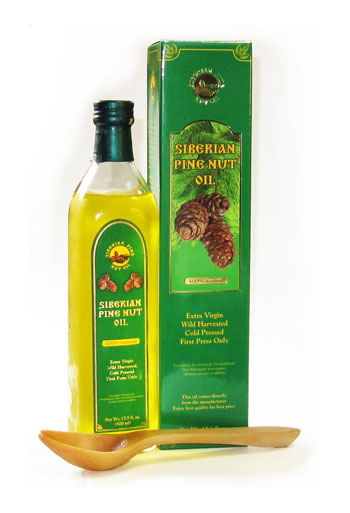
Siberian Cedar nuts (cedar nuts) contain about 60% oil. They are therefore pressed to obtain Cedar nut oil, which is available on the market as a very expensive gourmet cooking oil. Cold pressing in all-wooden presses is preferred to retain the nutritional properties of nuts and derive the oil of highest quality.
The Cedar nut oil bearing "The Ringing Cedars of Russia" brand comes exclusively from wild-harvested Siberian Cedar nuts - one of the most nutritious Cedar nuts in the world. In comparison, other Cedar nut oils are usually pressed from the Italian pignolia Cedar nuts, which are not nearly as potent and are often harvested from trees growing in plantations. Our Siberian Cedar nut oil is extra virgin (100% cold pressed from freshly shelled raw Siberian Cedar nuts), whereas most Cedar nut oils on the market are either not cold pressed or even pressed from roasted (!) Cedar nuts, which significantly decreases the oil value. Finally, "The Ringing Cedars of Russia" Siberian Cedar nut oil is the only one which is available on the market anywhere in the world pressed with wooden presses in accordance with traditional techniques described in Vladimir Megre's life-changing book "The Ringing Cedars of Russia". In contrast, all other Cedar nut oils are pressed using steel presses, which immediately degrades them (contact with steel oxidizes some of the Cedar nut oil's most important ingredients such as vitamins, and is known to remove the 'life force' from the oil).
Cedar nut oil has also traditionally been used in ancient Russian and European natural medicine to cure a wide array of ailments - ingested (decreasing blood pressure, boosting immune system resistance, etc.) or applied externally (a range of dermatological disorders). It is also used in expensive cosmetics.
Cedar nut oil contains pinolenic acid, a polyunsaturated fatty acid, and is marketed in the U.S. as a means stimulate cell proliferation, prevent hypertension, decrease blood lipid and blood sugar, and inhibit allergic reactions.
Copyright: http://www.RingingCedarsOfRussia.org/


GOAT CHEESE, PESTO, DRIED FRUITS AND CEDAR NUTS
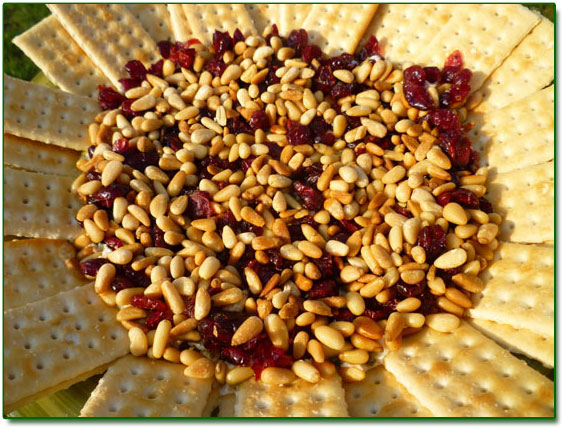
Ingredients:
2-4 oz packages soft goat cheese
4 - 6 T. Pesto
1/2 C dried Cranberries
1/4 C dried Apricots, diced
1/3 C Cedar Nuts, toasted
Your favorite crackers
Preparation:
Spread goat cheese in the bottom of low profile serving dish or plate. Spoon pesto on top and spread to cover goat cheese. Sprinkle mixture of dried fruits on top of pesto. Sprinkle toasted cedar nuts over dried fruits. Serve with crackers or toasted baguette slices.
Takes less than 5 minutes to prepare! Goat cheese is a breeze to spread if you remove it from the refrigerator a few minutes before you assemble this.
GOAT RICOTTA CHEESE AND CEDAR NUT STUFFED BABY ZUCCHINI
Ingredients:
8 baby zucchini
1-1/4 cups goat ricotta cheese
2 Tbs heavy cream
3/4 tsp soy liquid lecithin
2 tsp garlic powder
1/4 tsp nutmeg, freshly grated
8 Tbs cedar nuts, slightly toasted, + extra for garnish
1/3 cup mozzarella cheese , shredded
1-1/2 tsp sea salt
1/2 tsp white peppercorns, freshly ground
1/2 cup parmesan cheese powder
1-1/2 cups tomato sauce
1 shallot, finely chopped
2 cloves garlic, finely minced
3 Tbs flat leaf parsley, finely chopped
2 Tbs cedar nut oil
1 dry red chili, stemmed
2 tsp butter, melted
Preparation:
Stem the zucchini. Slice them lengthwise in half. Fill a pot with about 2 inches of water. Bring the water to a boil. Place a steamer basket in the pot. Add the zucchini to the basket. Lower the heat to a gentle simmer. Cover and cook for about 5-8 minutes, (make sure there is enough water to prevent the bottom from burning). The flesh should still be a little firm as the zucchini will finish cooking in the oven. Pat dry with a paper towel. Using a melon baller or a spoon, carve out the seeds of the zucchini and create a deep cavity. Set aside.
Preheat the oven to 375 degrees of F.
In a saucepan, heat the oil. When the oil is hot, add the dry red chili. As soon as the oil is infused, remove and discard the chili and reserve about 2 teaspoons of the oil. Cook the shallot in the remaining oil until it is slightly golden. Add the garlic. Cook for another 2 minutes, then add the tomato sauce. Season with salt and pepper if necessary.
In a mixing bowl, soften the goat ricotta cheese with heavy cream and liquid lecithin until you get a smooth paste-like consistency. Season with garlic powder, nutmeg, salt and pepper. Mix in 2 tablespoons of flat leaf parsley, about 1/4 cup of mozzarella cheese and 1/4 cup of parmesan.
Spoon a generous amount of the goat ricotta cheese mixture in each baby zucchini.
Brush a thin layer of butter in a casserole dish. Add the tomato sauce. Place the stuffed baby zucchini on the tomato sauce. Finish by sprinkling the rest of the mozzarella cheese and powdered parmesan cheese.
Bake for about 15-20 minutes. Remove from the oven. Immediately drizzle the rest of the chili-flavored cedar nut oil. Finish with some toasted cedar nuts and flat leaf parsley.
RICOTTA PASTA WITH FENNEL
Ingredients:
1 (16-ounce) package pasta (I used trottole pasta)
2 tablespoons cedar nut oil
1 yellow onion, sliced
1 fennel bulb
3/4 teaspoon fennel seeds (optional), ground to a fine powder
1/4 teaspoon cayenne pepper, to taste
1-1/2 tablespoons unsalted butter
1 clove garlic, finely minced
1/3 cup ricotta cheese
1/3 cup half and half (see tips)
1 (15-ounce) can small white beans, drained
1 lemon
1/3 cup cedar nuts
1/2 teaspoon salt
3/4 teaspoon mushroom seasoning salt (or regular salt)
1 teaspoon black pepper, freshly ground
1/4 cup fresh dill, finely chopped
2/3 cup parmesan cheese, freshly grated
Preparation:
Lightly dry toast the cedar nuts in a small skillet over medium high heat until slighted golden. You have to be very careful; otherwise the cedar nuts could burn easily. Transfer to a plate.
Zest and juice the lemon. Set them aside, separately.
Discard the stalk of the fennel bulb (or keep for garnish) and thinly slice the bulb (see tips).
In a large pan, heat the cedar nut oil. Add the onions. When the color is translucent. Add the sliced fennel bulb and stir-fry. Cook until slightly browned for 2-3 minutes. Season with about 1/2 teaspoon of mushroom seasoning salt. Add about 1/3 cup of water. Toss by shaking the pan for about 3-5 minutes. Add the cayenne pepper and ground fennel. Transfer to a platter and drizzle with a tablespoon of lemon juice. Set aside.
Bring about 5 quarts of water to a boil. Add the pasta, bring back to a boil and immediately lower the heat to a gentle boil. That way the pasta is cooked all the way through evenly. Cook the pasta for about 10-12 minutes total. Salt (with 1/2 teaspoon) the water half-way through the cooking process (it will bring out the natural flavor of the pasta and the pasta will be more tender) and keep stirring every now and then so the pasta doesn't stick to the bottom of the pot. It may take longer than the cooking time that's written on the box. When the pasta is cooked (cooked inside and out but still in shape and firm), transfer it to a large flat platter (you can also skip this step and directly transfer the pasta to the saute pan).
In a large saute pan or a large wok, heat the oil. Add the garlic and cook until slightly golden. Add the trottole pasta and butter. Toss the pasta by shaking the pan for about 2-3 minutes. Season with 1/2 teaspoon of mushroom seasoning salt and 1/2 teaspoon of black pepper. Spread the ricotta cheese uniformly over the pasta and add the half and half, lemon zest and remaining lemon juice. Toss for another 2 minutes. Turn off the heat. Add the braised fennel and white beans. Sprinkle with 3 tablespoons of dill and parmesan cheese. Cover and let it sit for about 5-10 minutes. Transfer to a large serving platter. Add the cedar nuts and garnish with the remaining dill.
Serve warm. Serves 6
http://thechefinmyhead.blogspot.com/; http://www.phamfatale.com/
CEDAR NUTS CAN BE SUBSTITUTED WITH CEDAR NUT FLAKES.
For more recipes please click here

For Educational purposes only
This information has not been evaluated by the Food and Drug Administration.
This information is not intended to diagnose, treat, cure, or prevent any disease.
These articles come directly from researchers and are passed on to everybody. The company assumes no liability for any content in these articles.
For more great articles go to http://www.ringingcedarsofrussia.org/cedar_nuts_and_ringing_cedars_information.php